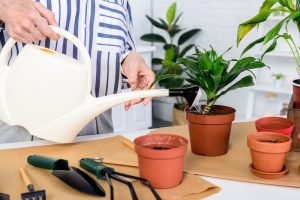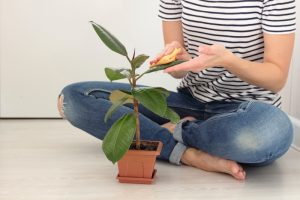The benefits of keeping house plants are well understood and there really is such a variety of plants that can be brought indoors that you should have no trouble finding one, or more you love to suit your home.
It is true though that most house plants would probably prefer to be outside in their natural habitat. They do require a bit of extra care when they are brought indoors. The flourishing of indoor plants is dependent upon providing the right amounts of light, water and nutrients. The trick is in finding the correct balance for each individual plant.

Knowing the right amounts to provide your house plants with requires an understanding of the requirements for the type of plant in general, but also getting to understand the needs of your specific plant. Where it is located in your house, the ambient air temperature, the humidity, the size of the pot, the size of the plant and other factors will all affect how fast your plants grow and therefore how much light, water and nutrients they will need.
Getting to know your plants, observing them and responding to them is key to having thriving house plants. And the good news is there is so much information available to help you create the ideal environment for your plants. You won’t have to look far to find the answers you need for taking care of indoor plants in your home.
7 Essential Tips for Taking Care of Indoor plants
1: Choose the right plant
There may be no such thing as indestructible house plants, but choosing the right house plant for the right spot will go a long way to keeping your house plants alive and thriving. You need to think about where the plant will go, how much space and light is available? Will the plant suit your interior style? Do you have the necessary time to care for it? Is it a plant that requires a lot of care or will the occasional watering keep it happy?

When buying a new house plant consider whether it can be grown inside permanently or whether it is a temporary house plant. Some plants have a very short lifespan (annuals) and no matter how well you take care of them, their life will be short-lived. Other plants are fine to bring inside during winter but then may need to go outside during summer.
Look for a healthy plant with thick, lush foliage. New growth on the plant is usually a good sign of a thriving plant. Avoid plants displaying any signs of insect attack or disease and remember that plants coming straight from nurseries have not only been given the perfect environment to grow in but sometimes are given special treatments to produce prolific flowers or new growth that you won’t be able to replicate at home.
When you bring a new plant home it may take a little while to adapt to its new environment, so give it time and continue to follow the remaining guidelines for taking care of indoor plants. And remember to read the care instructions. If they say the plant needs bright, filtered light, it’s probably not going to survive in a hallway.
Some nearly indestructible house plants for beginners include spider plants, peace lilies, snake plants, pothos and philodendrons. Succulents are great for a well-lit spot and are generally low maintenance.
2: Moderate the watering

Watering is possibly one of the most difficult aspects of caring for your house plants, initially. We all know that plants need water to survive but the balance is to be found in how much water and how often. The simple rule is that most house plants don’t like to have wet feet. The roots also need oxygen to grow. Sitting in soggy soil will encourage root-rotting diseases for the majority of house plants.
The use of a soil moisture meter can be very helpful when you are getting started. More house plants die by well-meaning owners who are doing their best to take care of their indoor plants, but actually end up overwatering them. Before watering, lift your pot and feel how heavy it is. You will get to know how much water it has by its weight. Then check the top inch of soil. For many indoor plants the top layer of soil can dry out before watering, whilst others need to be kept moist.
Water your plants thoroughly and allow the water to drain through. Keeping plants in a double pot or using a saucer allows excess water to drain away, just remember to empty the excess water. Generally plants need more water during the growing months of spring and summer, sometimes 1 – 3 times a week. In winter, water sparingly as your plants will be in a resting phase and their requirement for water is significantly less. Watering 1-3 times a month will usually be enough for taking care of indoor plants in winter.
The best advice is to research your plant and find out what its specific watering requirements are. And try to avoid getting into the habit of watering your house plants on a specific day. Instead learn to water them when they need it.
3: Let the light shine
Placing plants in your home to access the light they need is really important for healthy growth. Most plants need 12- 16 hours of light per day, but the required intensity of that light varies from plant to plant. Some can grow in shade-equivalent spots while others require much brighter light.
In our homes, the light intensity drops dramatically as you move away from a window and this will affect where plants can be placed for optimal growth. Foliage plants generally require bright light but need to be protected from direct sunlight. Some foliage plants can adapt to lower light levels but their growth may be slower. Variegated plants tend to require brighter light to maintain the variegation in their leaves. Cacti and succulents usually have the highest requirement for light and can be placed on a windowsill with direct sunlight.

Although natural light is preferable, artificial lighting can provide sufficient light for taking care of indoor plants. Fluorescent lighting can be used and there are now a huge variety of LED grow lights available. The use of these lights can promote the growth of flowering pants indoors, which usually need some direct light, and can even allow for some fresh produce to be grown indoors.
4: Feed your plants
Growing plants in pots means that they have a limited supply of nutrients. Not all house plants require large amounts of feeding and it is always best to check the care instructions for your plant when you purchase it. It’s also important to remember that when plant growth is minimal, usually in winter, no feeding is required. This is the case for the majority of house plants.
There are a variety of fertilisers available for plants, but when taking care of indoor plants, liquid fertilisers are definitely the preferred option. These provide an even supply of nutrients to the entire root system and are easy to limit when a plant is in its resting phase. Before feeding newly potted plants, it’s important to check the soil type as some potting mixes are enriched with fertilisers that will provide nutrients for an extended period of time. Always check the label on the potting mix as overfeeding can cause problems for house plants.
5: Repot when needed
The pots and soils that you use are important when repotting house plants. Generally they only need to be repotted if they are root bound. Spring is the best time to repot most house plants to allow the roots to become well-established during the growing season.
Self-watering pots have become quite popular however they do have their limitations. They can be ideal for plants in locations where it is not possible to water them regularly, however it is easier to overwater a plant in a self-watering pot. Extra care needs to be taken when using self-watering pots as allowing pots to drain helps to prevent root rot which can be fatal for indoor plants.

When it’s time to repot, choose a pot size that is only slightly larger than the original pot. Going from a small pot to a larger pot can shock a plant and stunt its growth. Before removing a plant from its original pot give it a good water and allow it to sit for half an hour to soak through. When it’s time to replant, gently tease the outside roots out and inspect for any damaged roots. Remove these but avoid too much damage to the root system.
The new pot should have a layer of moist potting mix on the base on which the plant can be rested. Then simply backfill around the sides with more moist potting mix, gently easing it down the sides of the pot. Tap the pot on the ground a few times to settle the soil and then give it a water.
For large pots the top couple of inches of soil can be removed and replaced with fresh soil. Clumping plants can be easily divided when repotting to propagate new plants. Take care to ensure all clumps have sufficient leaves for growth. It can also be helpful to mist the leaves for the first week after repotting.
6: Monitor for signs of trouble
Browning or yellowing of individual leaves can be due to old age and these can simple be removed, and the plant looks healthier. However, if a few leaves are looking unhealthy and browning or yellowing at the same time, or regularly, there may be a problem with the watering or light being provided for your plant. Observe your plants to identify any potential changes and act quickly to work out the cause of the damage. Taking care of indoor plants does require you to become a close observer of your plants.
Overwatering can cause leaves to develop brown patches and become soft or mushy. Leaves may become discolored and young and old leaves alike may drop off the plant. Underwatering tends to cause brown leaf tips or crunchy and curling leaves that may also turn yellow. Too much light or not enough light also affects the health of the leaves and sometimes the humidity or temperature can be important when taking care of indoor plants.
Watch out for pests and diseases on your plants and if you spot any act quickly to treat them. Serious infestations can become fatal. Sometimes repeated treatments are necessary to completely remove the threat. Removing dead and unhealthy leaves can help to reduce the risk of pests and disease.
7: Little things matter

- plants like fresh air in preference to being placed under AC/heating vents
- room temperature water is best for watering indoor plants
- rotate pots about 1/4 turn each week to encourage even growth towards light
- plants often grow better grouped together because the humidity increases
- leaves of indoor plants may need to be wiped with a soft damp cloth to remove dust
- learning how to prune your plant can help them to grow better
- propagating plants can be fun and rewarding
- consider plant toxicity if you have young children or pets
Enjoy Taking Care Of Indoor Plants
Growing indoor plants is a lot of fun and can even be a lovely way of providing thoughtful gifts for friends as many of the common indoor plants can be easily propagated. Bringing nature inside your home helps to reduce stress levels and many indoor plants are very effective at cleaning and purifying the air. One of the most important lessons to learn when taking care of indoor plants is to persevere, you won’t always get it right, but keep on trying, learn from your mistakes and have fun!




